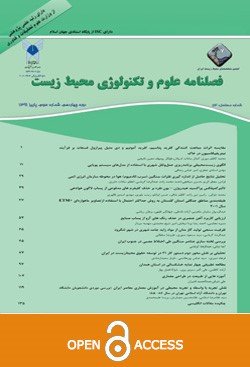Investigation of hospital wastes management variables and their adaptation with ISO 14001 standard
Subject Areas : environmental managementMohammad Saleh Ali-Taleshi 1 * , Farhad Nejadkoorki 2 , Hamidreza Azimzadeh 3 , MohammadTaghi Ghaneian 4 , Mahdieh Namayandeh 5
1 - MSc in Environmental Engineering, Yazd University, Yazd, Iran. * (Corresponding Author)
2 - Associate Professor, Department of Environment, Faculty of Natural Resources, Yazd University, Yazd, Iran.
3 - Associate Professor, Department of Environment, Faculty of Natural Resources, Yazd University, Yazd, Iran.
4 - PhD in Epidemiology, Cardiovascular Research Center, Shahid Sadoughi University of Medical Sciences, Yazd, Iran
5 - PhD in Epidemiology, Cardiovascular Research Center, Shahid Sadoughi University of Medical Sciences, Yazd, Iran
Keywords: waste, Hospital, Standard, ISO 14001, Yazd,
Abstract :
Abstract Background and Objective: The optimal management of hospital waste is essential to protect the public health and environment. The aim of the present study is to investigate the variables of hospital waste management in terms of their compliance with the ISO 14001 standard. In addition to identivying the weaknesses of waste management, some strategies are presented overcome them. Method: This study was carried out in 2013. The required data for hospital waste sector were obtained using a questionnaire and the Tables designed by World Health Organization (WHO). Condition of the environmental management of the wastes was described using the questionnaire, the environmental management system standard (ISO 14001), the national standard of Iran, and Likert range. All the data were analyzed by SPSS 16. Findings: Results showed that the conditions in the studied hospitals were lower than the hypothetical average (3) in terms of some variables such as identification of environmental aspects, planning for achieving the macro and micro goals; receiving the necessary training, drafting functions and responsibilities of waste management, and preparation for emergency response. In order to identify the environmental aspects of hospital waste, results showed that from 2307.82 Kg of the waste produced in hospitals daily, 62.23% were general waste, 36.17% were infectious waste and 0.58% were sharp substances. There was a significant correlation between the numbers of provided services in hospitals and the rate of daily generated waste (r= 0.992، P=0.008). Moreover, there was a significant regression relation between the overall area of hospitals and the rate of daily generated waste (P=0.02).
1- Al-Khatib, I. A., Sato, C., 2009. Solid health care waste management status at health care centers in the West Bank – Palestinian Territory. Waste Manag, 29(8): 2398-2403.
2- Abdel-Salam, M. M., 2010. Hospital waste management in El-Beheira Governorate, Egypt. J Environ Manag, 91(3): 18-29.
3- World Health Organization (WHO). Health-care Waste Management, policy paper. 2004, Online, Cited Nov 23, 2013, http://www.who.int/entity/water_sanitation _ health/medical waste/en/hcwmpolicy.pdf.
4- فضیلی، افسانه، صالحی، اسماعیل، عبدلی، محمدعلی، جعفری، حمیدرضا، شیخ پور، مژگان، 1389، بررسی فرایند مدیریت پسماندهای بیمارستانی در کرج، مجله محیطشناسی، 36، 53: 99-106.
5- Banar, M., Cokaygi, l. Z., Ozkan, A., 2009. Life cycle assessment of solid waste management options for Eskisehir, Turkey. Waste Manag, 29 (1): 54-62.
6- Gottinger H. W., 1988. A computational model for solid waste management with application. European J Operational Research, 35, 350-364.
7- Dehghani M. H., Azam, K., Changani, F., Fard, E.D., 2008 Assessment of medical waste management in educational hospitals of Tehran university medical sciences. Iranian J Environmental Health Science & Engineering, 5 (2): 131-136.
8- Askarian, M., Vakili, M., Kabir, G., 2004. Results of a hospital waste survey in private hospitals in Fars province, Iran. Waste Manag, 2004; 24 (4): 347-352.
9- Tsakona, M., Anagnostopoulou, E., Gidarakos, E., 2007, Hospital waste management and toxicity evaluation: a case study. Journal of Waste Manag, 27 (7): 912-920.
10- World Health Organization (WHO).Management of Solid Health-Care Waste at Primary Health-Care Centers. World Health Organization, Geneva, Switzerland, 2005.
11- Khan, F.I., Raveender, V., Husain, T., 2002, Effective environmental management through life cycle assessment. J of Loss Prevention in the Process Industries, 15: 455-466.
12- Dettenkofer, M., Kummerer, K., Schuster, A., Muhlich, M., Scherrrer, M., Daschner, D. F., 1997, Environmental auditing in hospitals: approach and implementation in a university hospital. J of Hospital Infection, 36: 17-22.
13- Gallup, J., Marcotte, B., 2004, An assessment of the design and effectiveness of the Environmental Pollution Prevention Project (EP3). J of Cleaner Production, 12: 215-225.
14- Campos LMS., 2012, Environmental management systems (EMS) for small companies: a study in Southern Brazil. J of Cleaner Production, 32: 141-148.
15- Corbett, C. J., Kirsch, D.A., 2001, International diffusion of ISO 14000 certification. Production and Operations Manag, 10 (3): 327-342.
16- Petroni, A., 2001, Developing a methodology for analysis of benefits and shortcomings of ISO 14001 registration: lessons from experience of a large machinery manufacturer. J of Cleaner Production, 9 (4): 351-364.
17- رضازاده نیاورانی، محمدرضا، ایزو 14001: 2004، سیستمهای مدیریت زیستمحیطی- الزامات همراه با راهنمای استفاده، چاپ اول، انتشارات نورپردازان، مشارسیستم، 1384، جلد اول، فصل اول.
18- Pru¨ss, A., Giroult, E., Rushbrook, D., 1999, Safe management of wastes from health-care activities. World Health Organization. Geneva.
19- Hyde, P., Reeve, P., 2004, Essentials of Environmental Management. IOSH Services Limited, P. 237.
20- Tudor, T. L., Noonan, C. L., Jenkin, L. E., 2005, Healthcare waste management: a case study from the National Health Service in Cornwall, United Kingdom. Waste Manag, 25 (6): 606–615.
21- Mato, R. R. A. M., Kaseva, M. E., 1999, Critical review of industrial and medical waste practices in Dar es Salaam city. Resources, Conservation and Recycling, 25(3-4): 271–287.
22- Shapiro, J.S., Genes, N., Kuperman, G., Chason, K., 2010, Health information exchange, bio surveillance efforts, and emergency department crowding during the spring 2009 H1N1 outbreak in New York City. Annals of Emergency Medicine, 55 (3): 274-279.
23- علی طالشی، محمدصالح، نژادکورکی، فرهاد، عظیمزاده، حمیدرضا، قانعیان، محمدتقی، نماینده، سیده مهدیه، 1394، مدیریت استراتژیک پسماندهای بیمارستانی با استفاده از روش:SWOT مطالعه موردی بیمارستانهای آموزشی شهر یزد، مجله سلامت و بهداشت، 6، 3: 291-303.
_||_
